Morozov
A.N.
Lecture 12. Methods of irrigation
starting from the depths of unrecorded time up to nowadays.
| Full
ignorance is not the highest evil, acquisition of having a poor grasp of knowledge
is even worse. |
| Platon |
There are hundreds of methods of
soil moistening, but amount of invention have only few of them:
Sprinkling
irrigation
Strip irrigation
Flood irrigation
Furrow irrigation
Drop irrigation
Subsoil irrigation
And
what is the difference between mentioned above methods of irrigation&
Sprinkling
irrigation is most natural way of irrigation; artificial application of it was
possible only after technological expansion (though watering cans were available
long before this method of irrigation). Several types of sprinkling irrigation
are known according to the purposes for:
- soil moistening;
- plants
freshening in hot time of days, i.e. for creation of appointed small scale climate;
-protection from spring frosts.
Water spraying requires some energy consumption.
The smaller drops of rain are required, the more energy consumption is required.
Rain intensity is defined by its permeability. It may be very high at soils with
high permeability; devices of smaller intensity are required at heavy soils (loamy
and clayed soils). However, undisturbed soils with natural structure regardless
of their size composition are specified by high capacity to absorb water unlike
arable lands.
Strip irrigation - it is soil moistening by water flowing
at its surface.
Flood irrigation - it is soil
moistening by filling of diked area with water.
Furrow irrigation - it
is soil moistening by water flowing along artificially developed furrows. Shape
of the used furrows are very various and it depends on physical properties of
the soils and
on kind of cultivated crops and plants. Furrows allocated in
parallel to isohipse lines are used at high slopes in mountainous and piedmont
areas with water overflow from the end of the upper furrow down to lower one (like
serpent)
Drop irrigation - it is kind of sprinkle
irrigation, but with delivering water drops strictly locally by the special device
- tricklers.
Subsoil irrigation, i.e. soil
moistening from below. It takes place owing to moistening by ground waters in
natural conditions, and water is delivered by special pipes installed at some
depth in soil when artificial method is used.
History
of soil moistening methods origination was started in ancient days. In the regions,
where rivers flooded their inundated lands, and sometimes even more vast territories
yearly, then farmers used this opportunity for sowing and cultivation of grains
and other short of duration crops, without any labor inputs for irrigation.
Essentially,
that was prototype of strip irrigation. Strip irrigation appeared when artificially
were repeated the situations that take place during natural flooding of rivers
at high water periods.
Water flows over soil
surface and sink in it when strip irrigation is used, the more even soil surface,
the more even flows water over it. Sections that located close to the water sources
(rivers, springs) are moistened with more degree, and located farther ones are
moistened not so much as the located closer ones. When inundations take place
in a small degree in years with low water, then most sections may commonly be
remained even without moistening.
An ancient
method of a kind of strip irrigation is also known that was used at piedmont area
at steep grade in Central Asia - that was so called micro-catchwork irrigation,
when a part of the plot located at higher elevations was compacted by layer of
clay mud mixed with empty glume and mill-straw and also sometimes with manure.
The plot was rounded by small guide dykes were used for moistening of area located
at lower elevations which also were rounded by small dykes. Chronologists wrote
that Timur-i-leng army had good supply with wheat from the areas irrigated by
this method.
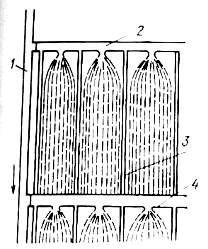
Picture
12.1. Strip irrigation.
(1 - field ditch;
2 -head ditch; 3 - small dykes that form strips; 4 - tubes or another discharge-outlets-water
regulating valves. (The picture was borrowed from F.R. Zaydelman's book "Soils
melioration")
Strip irrigation method
was developed at later stage by using of artificial diking of inundable areas,
by construction of stream deflectors and then also retaining dykes, which allowed
better control of water flow preventing the flows of spilling to river along depressions,
and that facilitated for better and uniform moistening of soil and even for its
desalinization from accumulated salts. Flood irrigation method was developed in
a way like that. It already required more input of work than strip irrigation,
but it made possible get better results in crop cultivation. Flood irrigation
required also certain works on irrigated lands leveling divided into small horizontal
plots (checks, plots).
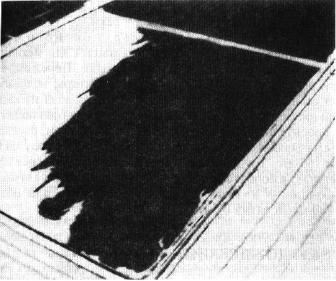
Picture
12.2. Aerial photo - flood irrigation of large size leveled plots (checks) where
flooding of large size plot can be seen. We used it to show how non-uniform the
area was irrigated. . (The picture was borrowed from F.R. Zaydelman's book "Soils
melioration")
To cultivate crops having
longer vegetation period, necessity of repeated irrigation arose as far as soil
dry and that lead to beginning of irrigation itself.
Together
with development of agricultural engineering with using of passing cultivating
equipment - furrow irrigation approach begun to develop, that prevail everywhere
over the world now. Its special feature is that flowing along furrow - small artificially
excavated ditch performed by special cultivating equipment - more or less uniformly
moistens soil without spilling outward.
Planting
along furrows allows better cultivation, carry out tillage, mechanize sowing and
ingathering. Furrow ridges are moistened only owing to capillaries and soil does
not soak and loose its structure and that improveû aeration in root zone
contribute to moist conservancy and facilitate weed control.
Disadvantages
of this feature are high unevenness of soil moistening along furrows and high
labor intensivity of water delivering uniformly to head of furrows. It is very
difficult to achieve uniform moistening of fields in longitudinal and crosswise
directions when soils surface have high slopes, and either flexible/rigid conduits
or various furrows shapes. Even at well leveled fields irrigation unevenness is
the reason why from 30% up to 40% of yield is lost.
So
far, even technical problem of water delivering to furrow heads because of head
losses "on way" of lengthwise delivery hoses at water distribution.
As well as, water should be discharged some time more after its reaching to the
ends of the furrows to be sufficient for sound moistening of tail piece of furrows.
It leads to water losses spent for unnecessary soil moistening (so called deep
water disposal) not only at the beginning of furrow but it also impose to useless
spill of water at tail piece of it (surface discharge of water). Actually, even
in most optimal cases amount of about 30% of water delivered from irrigation system
is lost, and that is harmful for soils meliorative condition at lands that are
subject to salinization and that is far from cheap when they pay to the system
for water delivering.
Furrow irrigation requires fine art in literal
sense. Irrigators should be familiar with topography and special features of their
fields and know how to manage with water and do it several times during an irrigation
adjusting water discharges into each furrow since there is no two furrows the
same even at well leveled field. They vary with slopes, permeabilities, degrees
of soil mechanical compaction by wheels of processing machinery. Any clod that
occasionally fallen in a furrow can change its cross-section significantly and
its ability to deliver water farther. When there are high discharges in a furrow
then may appear high velocities of water that wash soil out and remove fertile
layer (irrigation erosion of soil), and where low velocities take place then danger
of significant insufficiency of irrigation may be observed at end parts of the
fields. All that as far as irrigation developed, together with deficit of irrigation
water rising, led to necessity to find more sophisticated soil moistening methods
for crops cultivation regardless of their relative expensiveness.
First
of all, attempts to mechanize water distribution into furrows were performed by
dividing them into short sections, where water was delivered by movable pipelines.
These systems significantly increased efficiency of furrow irrigation and fields
watering uniformity, but because of their imperfection and expensiveness they
gave a place to sprinkler machinery.
Here is how described development of
these systems in the USA by Doctor of Science V.K. Sevruygin:
At first, manually
operated irrigation was replaced by irrigation with using pipelines, then pipes
were put on wheels and achieved a device for irrigation that has ability to move
(i.e. capable to move to any part of the field with the help of a tractor),
After that, the wheels designed to space perpendicularly to the pipes and they
lifted pipes over plants and have designed front wide-cut irrigating machine.
Afterwards, outlets from the pipes were replaced by irrigation nozzles and modern
wide-cut sprinkling machines were designed.
Further, to increase uniformity
of water distribution and of water losses reducing caused by windage and evaporation,
they drew the nozzles nearer to soil surface and supplied them with diaphragms
that automatically controlled water discharge.
As
a result, they achieved machines with the design that provided highest uniformity
of irrigation that work with hands-off operation, with having remote control over
the machines via satellites and that capable to irrigate huge massifs of lands
in accordance with programs given and with due attention to optimum operation
of irrigation. So, owing to creation of systems with closed irrigation network,
and of high grade irrigation technique, efficiency of irrigation systems draw
near to theoretically possible one - to 1,0.
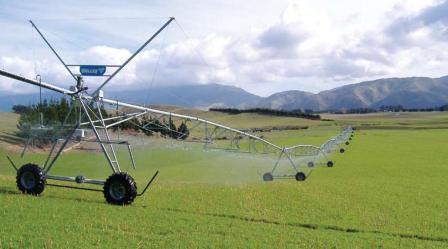
Picture 12.3. "Valley" machine with
irrigation nozzles close to soil surface at rolling terrain (the picture was borrowed
from advertising catalogue at "Valley" company website - http:\\www.valley-ru.com)
Sprinkling
machines also may be used against spring sharp radiation frosts. Water, when it
is frosting, it is giving up heat equal to 79,6 calorie/g, and plants temperature
is kept at range between zero up to -1///1,5 degrees of Centigrade while sprinkling
and plants can withstand to such temperatures. This method is most efficient for
protection of flowers and seed-buds of fruit and baccate trees. It is necessary
to ensure that intensive "rain" covers all the surface of flowered deflored
trees for all period of returned frosts (which usually lasted only a few hours.
Top of trees are sprinkled by hoses at which nozzles with fine overspray. Owing
to sprinkling flowers and see-buds are protected at air temperatures even down
to minus 4 - 5 degrees of Centigrade.
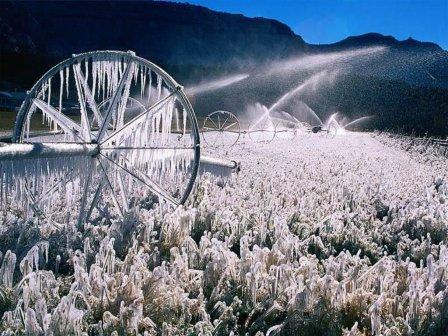
Picture
12.4. Sprikle irrigation to protect from frost by front sprinkle machine
Sprinkle
machines can be used for low-intensity irrigation of plants and to maintain microclimate
during day's hot hours, withstand hot winds and frosts. That may be mist generators
for fine moistening - йюс-1, synchronous-impulse sprinkling йяхд-1 and others.

Picture
12.5. Irrigation of small fruit acreages by йюс-1 system and of bushes by йяхд-1
sprinkling machine at the right (the picture and its processing is of "тцмс
бмхх пЮДСЦЮ")
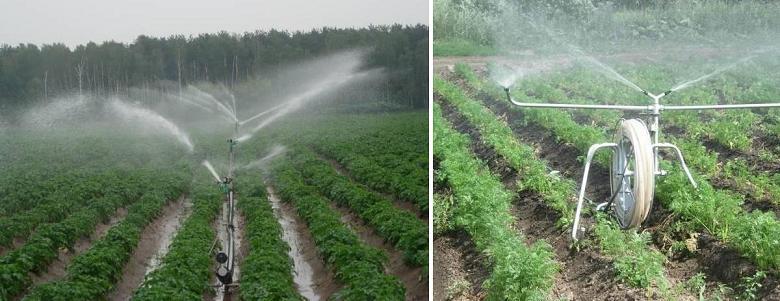
Picture
12.6. . Irrigation of vegetables by Rosinka sprinkling machine (the picture and
its processing is of "тцмс бмхх пЮДСЦЮ")
There
was invented an ingenious method of soil moistening in countries with limited
water resources which changed radically system of farming at irrigated lands providing
local water delivering to plants - drop irrigation. At this approach, irrigation
water purified through filters from coarse and fine suspended particles and it
is delivered to root zones of cultivated plants by using special devices - drips.
Capacity of drips are chosen in a way to irrigate plants practically constant,
not by separate irrigations (at this condition expenditures connected with the
pipes are getting minimal, otherwise, if water is delivered periodically, then
the required capacity of the pipes increases proportionally to relation of irrigation
interval to water application time). Fertilizers and crops protection agents may
be applied simultaneously with water delivering and that significantly increases
cultivated crops yield.
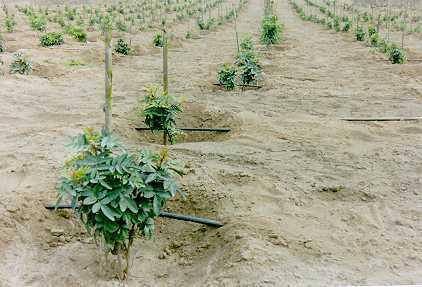
Picture
12.7. Drop irrigation system of a new garden.
Drips
of various forms were shown at Picture 12.9. Actually lot of drips design were
developed, it makes you dizzy when you search in Internet to see latest designs.
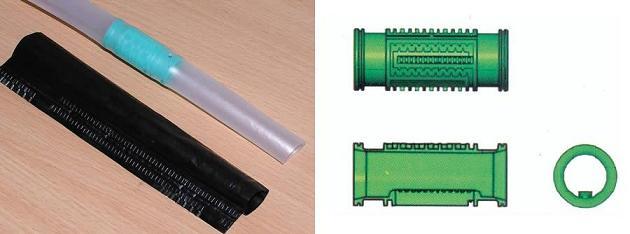
Picture
12.8 Various companies drip design. Pipes with built-in drips at the left, main
detail of the drip of DRTS firm's design which is built-in into distribution pipe.
One
of the main features of construction of good drips is their special "discharge
characteristic" - dependence of volume discharged from it in a definite time
on head in the pipe. Discharge characteristic of DRTS firm drip was shown at Picture
12.10.
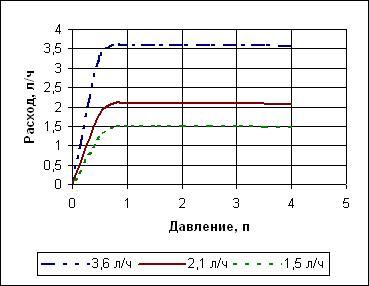
Picture
12.9. Discharge characteristic of DRTS firm drip
Please, pay attention
to that its discharge depends on head only in the range from 0 up to 0,8 m, but
then it is stable up to 4m head. That is achieved by selection of structural components
in a way which provides automatic regulation of the holes size and hence - fixed
rate of discharge. Such kind of drips provides with uniformity of irrigation of
field irrespective of the field slope and heads distribution along alignment of
delivering pipe
Design and a picture of drip irrigation system for country
house option were shown
at Picture 12.11. It is simple, money-saving and
productive!
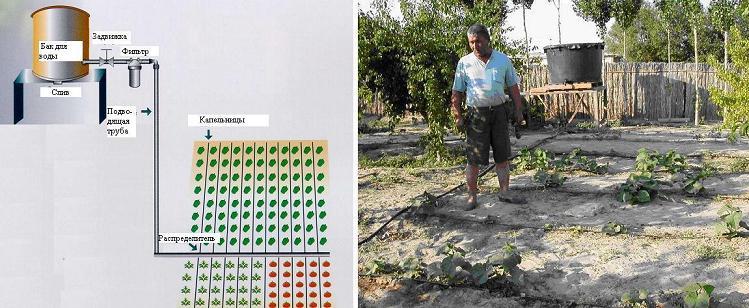
Picture
12.11. Drip irrigation system for country house option
There
were attempts for long time there to realize very interesting idea into practice
- subsoil moistening by using damper pipes which deliver water directly to root
zone and water is spent very little for evaporation from soil surface at this.
However, technical realization of that could not be achieved because of fast occlusion
of pipe mouths and of any other filter units by plant roots (regardless of pores
size). There were attempts to develop one season pipes with microcellular structure
but cost of that was so high that it could not be warranted by one season yield.
This problem was solved by periodical application of special chemicals, which
prevent of roots growing in situ of underground drips, and these systems you would
think are efficient like overground drip irrigation. However, the firms-manufacturers
of these systems do not inform us on how the chemicals impact to the plants, their
roots and to other soil "natures".
And one more question connected
with the life of soil itself, what will be with its fertility if its surface -
which is most active layer - is constantly dry all the summer season? There are
very alerting warnings on this question of well known throughout of the world
agrologists and farmers, and we shall tell about that in Lectures #17 and #18.
Well,
possibly it is enough to tell on irrigation procedures, and now, let us see, "what
does that give him" and how to select something that you need. We shall try
to show you one of possible options of irrigation method choice foundation as
an example in Lecture 16 .

